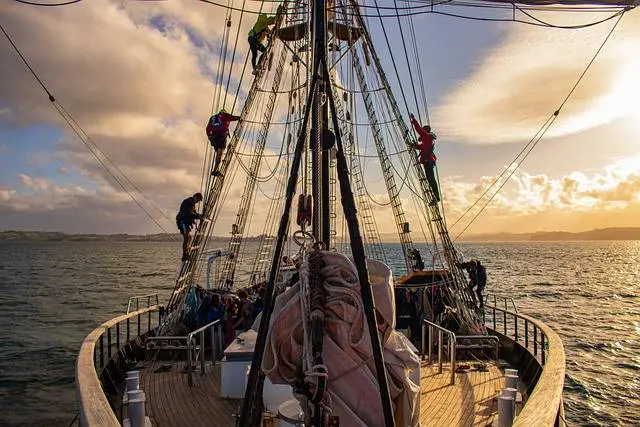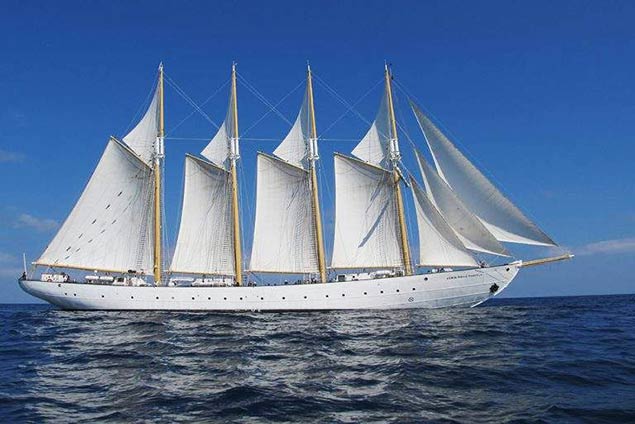When it comes to tall ships, there is one person who plays a crucial role in making sure that the vessel operates smoothly and efficiently: the captain. This individual is responsible for a variety of tasks, from navigating the ship to ensuring the welfare of the crew members.
In this article, we will dive deeper into the role of the captain on a tall ship, exploring the specifics of their duties and responsibilities to gain a better understanding of the important role that they play.
Navigating the Ship
Perhaps the most obvious duty of a captain on a tall ship is to be responsible for navigating the vessel. This involves much more than just steering the ship, however.
The captain must be able to read nautical charts and understand the various navigational aids and tools that are available to them. They must also be aware of the weather conditions and how they affect the ship’s movement, and adjust the course accordingly.
It’s important to note that navigation isn’t just about getting from point A to point B; the captain must also be able to plan ahead and anticipate any potential obstacles or hazards that the ship may encounter along the way.
Ensuring the Safety of the Crew
The captain’s primary duty also includes making sure the crew members are safe and healthy.
This entails putting in place safety guidelines and practices for all facets of ship operation, from handling the numerous sails to running diverse machinery.
The captain is also in charge of overseeing emergency drills and ensuring that everyone on board is aware of what to do in case of an emergency.
Managing the Crew
In addition to safety, the captain is also responsible for managing the crew.
This includes assigning duties and responsibilities to individual crew members, ensuring that there is adequate staffing for all tasks, and making sure that everyone is working together effectively.
The captain must also be skilled in conflict resolution and be able to resolve any disputes that may arise amongst the crew.
Maintaining the Ship
On a tall ship, maintenance is an ongoing task. The captain is responsible for ensuring that the ship is in good condition and that all necessary repairs and maintenance are carried out in a timely manner.
They must also keep track of inventory, making sure that there are adequate supplies of food, water, and other necessities on board.
Representing the Ship
Finally, the captain is also responsible for representing the ship and its crew. This includes interacting with other vessels and authorities, as well as the general public.
The captain must be able to communicate effectively and represent the ship and its crew in a professional and positive manner.
Why is the Captain so important?
The role of the captain on a tall ship has a rich and fascinating history, dating back centuries. From the Vikings to the Spanish Armada, captains played a critical role in navigating the seas and leading their crews to victory.
During the Age of Sail in the 18th and 19th centuries, tall ships dominated the world’s oceans, and captains were at the forefront of exploration, trade, and warfare. Some of the most famous captains in history include Horatio Nelson, who led the British Navy to victory at the Battle of Trafalgar, and William Bligh, who survived a mutiny aboard the HMS Bounty.
Captains on tall ships were responsible for everything from navigation and seamanship to diplomacy and discipline. They had to possess a wide range of skills and knowledge, including chart reading, celestial navigation, and ship maintenance. They also had to be able to manage their crew, which could number in the hundreds, and deal with everything from mutinies to outbreaks of disease.
In addition to their practical skills, captains on tall ships were also expected to embody certain values and ideals, such as bravery, loyalty, and honor. Many captains became revered figures in their own time, and their exploits and achievements inspired countless books, movies, and legends.
Today, while tall ships are no longer the primary mode of transportation or warfare, the role of the captain remains as important as ever. Whether they’re leading scientific expeditions, sailing around the world, or participating in races and regattas, captains on tall ships continue to inspire awe and admiration.
Final Word
In conclusion, the role of the captain on a tall ship is multifaceted one that requires a diverse range of skills and abilities.
From navigating the vessel to managing the crew, maintaining the ship, and representing it, the captain is a key figure in ensuring that the ship operates smoothly and efficiently.
It’s clear that the captain is far more than just a person who steers the ship, they are an essential member of the crew who plays a vital role in the success of the ship and the safety of all those aboard.




![8 Best Tall Ship Documentaries for History Buffs [Video] 8 Best Tall Ship Documentaries for History Buffs [Video]](https://www.tallshipssunderland.com/wp-content/uploads/2023/03/tall-ship-documentaries-150x150.jpg)
![The Importance of Safety Measures on Tall Ships [Video] The Importance of Safety Measures on Tall Ships [Video]](https://www.tallshipssunderland.com/wp-content/uploads/2023/03/tall-ship-safety-150x150.jpg)
